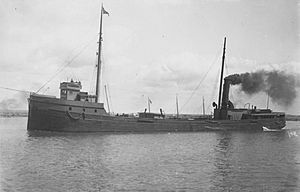SS Robert Wallace facts for kids

The Robert Wallace underway
|
|
Quick facts for kids History |
|
|---|---|
| Name | Robert Wallace |
| Operator |
|
| Port of registry | |
| Builder | William H. Radcliffe |
| Launched | April 13, 1882 |
| Completed | 1882 |
| In service | April 26, 1882 |
| Out of service | November 17, 1902 |
| Identification | U.S. Registry #110518 |
| Fate | Sprang a leak and sank on Lake Superior with no loss of life |
| General characteristics | |
| Class and type | Bulk Freighter |
| Tonnage |
|
| Length | 220 feet (67 m) |
| Beam | 36 feet (11 m) |
| Height | 19.6 feet (6.0 m) |
| Installed power | 1 × Scotch marine boiler |
| Propulsion | 550 horsepower compound steam engine |
|
Robert Wallace (bulk carrier) shipwreck site
|
|
| Location | 7 miles (11 km) south of Knife River, Minnesota |
| MPS | Minnesota's Lake Superior Shipwrecks MPS |
| NRHP reference No. | 09000828 |
| Added to NRHP | October 14, 2009 |
The SS Robert Wallace was a large wooden ship that carried goods on the Great Lakes in North America. Built in 1882, she worked for 20 years before sinking in 1902 in Lake Superior. Her wreck was found in 2006 and is now a protected historical site. On October 14, 2009, the wreck of the Robert Wallace was added to the National Register of Historic Places.
Contents
The Story of the Robert Wallace
The Robert Wallace (official number 110518) was built in 1882. William H. Radcliffe of Cleveland, Ohio built her for David Wallace of Lorain, Ohio. Lorain was her homeport.
She was 220 feet (67 m) long, 36 feet (11 m) wide, and 19.6-foot (6.0 m) deep. A 550 horsepower compound steam engine powered her. A single coal-fired Scotch marine boiler provided the steam.
The ship was launched on April 13, 1882. She often carried large amounts of goods. These goods included iron ore, coal, and grain.
Adventures and Mishaps
The Robert Wallace had several interesting events during her career:
- On August 2, 1883, she was pulling another ship, the J.M. Hill. Both ships were hit by lightning in the Milwaukee harbor. Their front masts were badly damaged.
- On November 18, 1886, the Robert Wallace was pulling her schooner barge, the David Wallace. This barge was named after Robert Wallace's brother. The Robert Wallace got stuck near Marquette, Michigan. She then caught fire and burned. Luckily, she was pulled free and fixed, so her career continued.
- On November 12, 1891, the Robert Wallace ran aground in Sheboygan Harbor. This happened because the water was too low. She was carrying coal and was also towing the David Wallace, which also got stuck.
- On October 22, 1896, the ship's boilers started leaking. They needed repairs in Harbor Beach, Michigan before she could continue her journey.
The Day She Sank
On November 17, 1902, the Robert Wallace left Superior, Wisconsin. She was full of iron ore and was also towing another ship, the Ashland, which was also full of iron ore.
About four hours after they left, the Robert Wallace began to leak and started sinking. People have different ideas about what caused the leak. Some say the Robert Wallace hit a floating log. Others believe the Ashland pulled off her back part (her stern post).
Her crew quickly moved to the Ashland. The Ashland then sailed to Two Harbors, Minnesota. A steel tugboat named the Edna G towed the Ashland to safety. Even though the Robert Wallace was full of heavy iron, she sank very slowly. For hours after her crew left, she floated on the surface of Lake Superior with her lights still on. When she finally sank, her pilothouse broke off and kept floating on the water.
Finding the Robert Wallace Wreck
Discovery
The wreck of the Robert Wallace was hidden underwater until 2006. An unknown diver found the wreck near the shipping lanes. This diver told Jay Hanson about the location.
In 2006, Jay Hanson and Ken Merryman explored the wreck. In 2007, Hanson and Merryman took video footage of it. Later, Merryman and Bob Olson officially identified the wreck. They saw her name, still painted in white letters on her stern (the back of the ship).
The Robert Wallace Today
The wreck of the Robert Wallace is still mostly in one piece. It rests in 240 feet (73 m) of water. This is about seven miles (11 km) south of Knife River, Minnesota.
Other shipwrecks are nearby, including the Onoko, the Benjamin Noble, and the Niagara. All these wrecks are also listed on the National Register of Historic Places.
The Robert Wallace wreck is the most complete wooden cargo ship found in Minnesota waters. Her front part is separated by about 35 to 40 feet (11 to 12 m), which makes it easier to explore. Many items are scattered outside the wreck. It is against the law to remove any items because the state of Minnesota protects the wreck. The back of the ship is still intact, which shows that the theory about the Ashland pulling off her stern post was likely not true.
The wreck was added to the National Register of Historic Places in 2009. It is important for understanding trade, engineering, and maritime history. It also helps researchers learn about the early designs of lake freighters and life on board these ships.




